Top 20 downloaded papers in the journal Environment and Urbanization
How can we measure – or what should we measure – to assess the influence of a paper or journal?

Different ways of measuring influence produce very different findings. For instance, a journal or an article with a high score for downloads can have a low score for citations – and vice versa. And citation scores vary a lot depending on what body of literature they are drawing on. Do they only include academic papers, or do they go wider?
This blog started life as an internal report on the influence of papers published by the journal Environment and Urbanization (E&U) for the years 2017-21.
But the editorial team felt that the issues raised were of broader interest, especially as to whether we have been meeting our goals: to have more authors from the global South; to attend to gender equality; to have both a global and a local focus; and to provide good coverage of COVID-19, climate change and community-driven processes.
Even more telling than what we publish though, is what people are actually reading. While we can’t know this for sure, we can tell what is being downloaded from our website – a reasonably good proxy. During 2021, there were 652,862 downloads of E&U papers from its official website.
Obviously, papers shared informally or redownloaded from other sources are not in this count, so the downloads are at best a rather conservative figure for papers read.
Getting the North/South balance right
Of the 20 most downloaded papers listed in the table below, 11 are by authors or co-authors from the global South. Despite great improvements in availability of information online and increasing numbers of open access papers, these authors still tend to have less opportunity to contribute to global or continental journals – including fewer resources and limited access to most journals.
They may have more funding constraints publishing in journals that are open access and authors have to pay. There are language barriers as for many English is a foreign language and which is why we accept paper submissions in French, Portuguese and Spanish, and work with authors with basic English to get their work published.
Progress on global South authorship has been strong, although there are some questions we should be answering to carry out a more systematic analysis of our overall track record in this regard.
For instance, we have authors from the global South who are currently working in the global North. How should they be classified? And should the contributors to multi-author papers get the same credit as solo authors, or should they be assigned a fraction of that paper’s authorship? Should the first author cited get a larger score than the others?
Addressing gender inequality from the outset
On the gender equality front, E&U has been committed to addressing gender-based inequalities from its foundation in 1989.
The journal has featured papers and special issues focussing on aspects of gender – along with guest editors who are leading feminists working in an urban context such as Caroline Moser, Sylvia Chant, Cathy McIlwaine, Caren Levy, Ann Schlyter, Ana Falú and Diana Lee-Smith.
Of course, not all papers on gender issues are by women and not all papers by women are on gender issues, but this is one good indication.
We should also note that some papers listed in the table are very strong on gender issues without this being their primary topic. For instance the slum/shack dwellers federations have an unremitting commitment to gender equality running through everything they do – even when the topic is sanitation or housing or mapping (see the paper which appears in the table on the work of the Philippines Homeless People's Federation).
Women authors dominate the top 20
Looking at the table of top 20 downloads perhaps the most notable feature is that most are authored by women, with only two papers lacking a female author or co-author. Eight of the ten most downloaded papers are written by women, and most single author papers are by women.
Some of these papers focus on gender – even in special issues that were not focused on gender. In these years, three papers are specifically on gender issues (livelihoods, urban violence, cities), although many other papers include some detailed coverage of gender issues – mostly around COVID-19 and climate change. Most of the discussions of gender focus on women’s practical needs (see the Moser Gender Planning Framework).
So it’s clear that gender equality is more than holding its own in E&U. To give credit where it is due however, we must also acknowledge that by far the most downloads are for a paper by two (very well known) men on urbanisation and economic growth.
Keeping it relevant
Papers about COVID-19 and climate change have also aroused much interest, with COVID-19 in the title of four of the 20 most downloaded papers, and climate change in two. Both topics also get plenty of coverage in other papers, especially those focusing on risk/disaster risk and resilience. Papers on the pandemic have focused mostly on local needs and responses, including community mapping and community-led responses.
There is a good mix among these papers in terms of scale (global or continental reviews versus community study and action). Three of the papers are on the big picture – the review of urbanisation and gender-based violence, city population projections and the discussion on African urban futures. There are two papers on sanitation – one with a national focus (India), and one at the city scale (Manila).
The number of downloads for each paper is useful, but tells us nothing about whether the downloaded papers were actually read. The number of citations is more informative on this – assuming that the literature cited was read.
But many papers (and their journals) do not meet the conditions required by whatever institution is managing the recording of citations. For instance, Annie Wilkinson’s paper on COVID-19 in informal settlements (at number three in the table) received 167 citations in ‘Google Scholar’ but only 84 in the ‘Web of Science’.
Grateful thanks to fellow members of E&U’s editorial board, Sheridan Bartlett and Diana Mitlin, for their comments and suggestions.



